|
TRANSLATIONS
The following are the pages with
'preliminary remarks and imaginations' of the toki 'chapter':
|
A few preliminary
remarks and imaginations:
1. This type of glyph
perhaps originates from the image of
a shepherd's staff. But it may be that it is intended to show an
adze (toki).
"A Maori saying: he iti toki,
e rite ana ki te tangata = though the adze be small, yet does it
equal a man." (Starzecka)
It is a male attibute, and a chief must carry a big 'stick':
"The Araukan Indians in the coastal area of northern
Chile, have customs similar to those on the Marquesas and in both areas
toki means adze according to Josť Imbelloni. The Araukans also
called their chief of war toki and the ceremonial adze symbolized
his function and was exhibited at the outbreak of war. In Polynesia
Toki was the name of a chief elevated by the Gods and his sign was
the blade of a toki." (Fraser) [Or was it a henua
sign?]
"... A depiction of an adze was also used as a
hieroglyph, representing the consonants stp, 'chosen' ... Pharaoh XX, chosen of God/Goddess YY..." (Wikipedia)
A big stick ought to be represented in the rongorongo texts as a
big toki sign, if we can rely on Metoro's identification
of this glyph type as a picture of an adze:
|
 |
 |
|
Aa1-64 |
Ga2-1 (32) |
|
|
2. As an
emblem of power
the 'stick' must have a history far older than man. The
α male dominates the group not
only among primates but also among other 'higher' animals (wolfs,
lions and so on). The first letter, aleph,
is a picture of The Bull. Prehistoric man used a spear to overcome
even the most formidable of beasts.
With agriculture another kind of stick became the digging tool. The
bull sign is alluded to in the Egyptian hieroglyph for mattock:
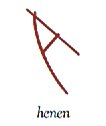
Furthermore, the word 'mattock' seems to be related
to the words 'bullock' and 'ballock'. Wilkinson mentions that the
religious digging of the earth appears to be very old. In the Pyramid
texts it is said, in connection with offerings to the deceased king:
The mattock has picked the soil, offers have been carried forth ...
O Geb (the god of earth), open your mouth for your son Osiris.
The following picture (in Wilkinson) from a tomb is illuminating:
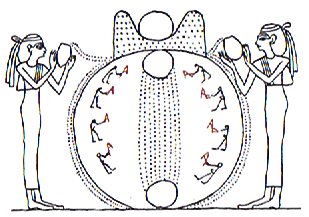
The goddess at left is younger (not so tall as the
one at right, and the vessel she is holding is not so big as the one
in the hands of the goddess at right). 4 + 4 males are holding
henen [is it only coincidence that this word resembles henua?] signs and these men are also larger at right (and growing
from top to bottom). 5 + 4 lines of dots connect the hole at the top
with the hole at the bottom, and possibly the sun is depicted as
going down at
the very top outside the central circular form.
I tried to count the dots in these 9 lines - guessing
they might mean nights or something of the sort - and this is the
result:
|
1 |
2 |
3 |
4 |
5 |
6 |
7 |
8 |
9 |
|
28 |
26 |
23 |
25 |
26 |
25 |
25 |
27 |
29 |
|
128 (= 8 *
16) |
106 (= 2 *
53) |
These numbers do not seem to be arbitrary. 128 (= 28 +
100) apparently serves to indicate the primary season, the season of
growth. If the 9 dotted lines indicate the 'back side' of the year,
then it will be 128 + 106 = 234 days long. 230 (the front side
according to G) + 234 = 464.
The dots surrounding the sun sinking low at the top
appear to be 80 in number, and this would result in a satisfying 128 + 106
+ 80 = 314 (= 464 -150). If the year gives 10 times 30 days to the
sun, then half 300 should account for the 'front side'. If so, the
total length of a year would be 150 + 314 = 464 = 16 * 29 days (or rather 8 * 58
because there are 8 men digging).
Another way to count the total length of the year
could be to add the dots formed by the fluids
from the goddesses' vessels.
|
|

|
1 |
2 |
3 |
4 |
5 |
6 |
7 |
8 |
9 |
|
28 |
26 |
23 |
25 |
26 |
25 |
25 |
27 |
29 |
|
128 |
106 |
The fluids form double rows of 'droplets' (and the
goddesses surely must represent the two faces of the moon). Each
such double row is divided in two parts, a shorter part from the
vessel to the mountain with double peaks and then a longer part from
there to the bottom.
|
left stream
of dots |
right stream
of dots |
|
short part |
long part |
short part |
long part |
|
17 + 15 = 32 |
58 + 66 =
124 |
10 + 10 = 20 |
46 + 58 =
104 |
|
156 |
124 |
|
280 |
280 probably represents the number of nights moon is
illuminated from the light of sun during 10 months or 20 fortnights.
If we add 80 dots (inside the mountain with double peaks) we will
reach 360.
The fundamental topological division into inside and
outside has 128 + 106 = 234 dots on the inside of the central circle
and 280 on the outside. To this must be added the dots inside the
doublepeaked mountain. 234 + 80 = 314 is the number of dots inside
either the central disc or the doublepeaked mountain.
Another possibility is to add the redmarked numbers:
128 + 280 = 408, which can be said to reflect 10 months with 32 days
in each (because 40 * 8 = 320). This number apparently occurs as the
ordinal number (counted from Gb8-30) of the last glyph before
Rogo:
 |
 |
 |
 |
 |
 |
 |
|
Gb6-25 (408) |
Gb6-26 |
Gb6-27 |
Gb6-28 |
Gb7-1 |
Gb7-2 |
Gb7-3 |
The blackmarked 106 above will then, of course, be
paired with those 80 inside the doublepeaked mountain: 106 + 80 =
186, which could indicate the 'nighttime' duration of the year. 18 *
6 = 108, a well known mythical number, and this can 'boil down' to
10 * 8 = 80. 108 + 300 = 408.
If we regard the standard year as 360 days (which
the Egyptians did), then 360 - 186 = 174 = 6 * 29 = 464 - 290. If we instead
count with 6 * 29.5 = 177 days for half a year, then 177 + 186 = 363
(the day of Rogo) = 354 + 9. 472 - 295 = 177.
The number of dots in
the picture above are, though, hard to count with certainty. My
numbers must therefore be considered as purely guesswork.
|
|
3.
There could have been
a month named toki on Easter Island according to
Fischer who refers to Fedorova. I cannot say where in his
book this statement is to be found, his
index is not very informative, and I rely on my earlier notes.
If there was a toki month, it ought to be at the beginning of the
year or maybe at the beginning of the
'back side' of the year. Makemson has no list for the month names
on Easter Island (and neither for those on Mangareva for that matter). The lists of months
according to other Polyesian Islands show no consensus and are
therefore not much of a guidance. However, I have tried to
'decipher'
the Futuna month names.
To open the 'mouth' of the earth god (Geb) in order
to let the deceased enter should be an event in the west (and the Egyptians had
their graveyard to the west of the Nile).
The last regular month on
Futuna was Munifa and fa (= ha) means 'to
breathe' among other things. 4 (ha) respectively 8 (varu)
appear to be connected with 'dismantling' (cfr the process of
embalming at rima aueue):
| Ha
1. Four. 2. To breathe. Hakaha'a,
to flay, to skin. Vanaga.
1. Four. P Mgv., Mq., Ta.: ha,
id. 2. To yawn, to gape. 3. To heat. 4. Hakaha,
to skin, to flay; unahi hakaha, to scale fish.
Mgv.: akaha, to take to pieces, to take off the
bark or skin, to strip the leaves off sugarcane. 5. Mgv:
ha, sacred, prohibited. Mq.: a, a sacred
spot. Sa.: sa, id. Churchill. |
|
Unahi
Scale of
fish; unahi varuvaru, to scale; unahi
hakaha, to scale. P Pau., Ta.: unahi, to
scale fish. Mgv.: unahi, fish scale, to scale.
Mq.: unahi, id. Churchill. |
|
Varu
1. To cut one's hair (te puoko).
2. To shave. 3. To paint, to put on make-up: he varu
te kiea. Varu a-roto, to have diarrhoea.
Vanaga.
1. Eight. 2. To shave, to remove the
beard, to shear, to clip, to rasp, a plane. Varuvaru,
to peel, to remove the bark, to plane, to scrape, to
shear. Churchill. |
|
Varua
Spirit, soul; sleep, dream. This is a
Tahitian word, but the same term may have been used in
ancient times. Vanaga. |
... My little dogs, I get them food, / My little dogs, I get
them food, / ha-ahing, ha-ahing, ha-ahing ....
To breathe is a sign of life and it comes naturally if you
open your mouth, especially if you yawn (ha). To give off heat (ha) is the opposite of
being cold and dead. We can guess that important toki sign conveys
a similar spectrum of meanings. The end is in time an event
close to its opposite.
I think that to 'enter or
become the sky' (presumably an event in the east) will be
accomplished by yet another kind of 'stick', the cosmic 'tree':
... the Palenque scribes repeated Creation again and described it as
'it was made visible, the image at Lying-down-Sky, the
First-Three-Stone-Place'. Then we learned that five hundred and
forty-two days later (1.9.2 in the Maya system), Hun-Nal-Ye
'entered or became the sky' (och ta chan). This 'entering'
event occurred on February 5, 3112 B.C. The act of 'entering the
sky' is recorded on another extraordinary painted pot.
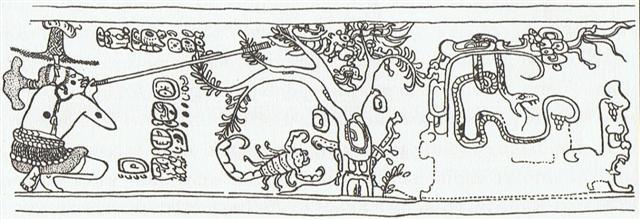
This pot depicts one of the Hero Twins (One-Ahaw in the Classic
texts and One-Hunaphu in the K'iche' Popol Vuh) and a great
bird who is trying to land in a huge ceiba tree heavy with fruit.
This mythical bird is Itzam-Yeh, Classic prototype of
Wuqub-Kaqix, 'Seven-Macaw', of Popol Vuh fame.
In that story, in the time before the sky was lifted up to make room
for the light, the vainglorious Seven-Macaw imagined himself to be
the sun. Offended by his pride, the Hero Twins humbled him by
breaking his beautiful shining tooth with a pellet from their
blowgun. This pot shows One-Ahaw aiming at the bird as he swoops
down to land in his tree. As Itzam-Yeh lands on his perch,
the text tells us he is 'entering or becoming the sky'.
This particular 'sky-entering' is not the one mentioned in the
Palenque text. It is the final event that occurred in the previous
creation before the universe was remade. Before the sky could be
raised and the real sun revealed in all its splendor, the Hero Twins
had to put the false sun, Itzam-Yeh, in his place. If the date on
this pot corresponds to that pre-Creation event, as we believe it
does, then Itzam-Yeh was defeated in 12.18.4.5.0 1 Ahaw 3
K'ank'in (May 28, 3149 B.C.). After the new universe was finally
brought into existence, First Father also entered the sky by landing
in the tree, just as Itzam-Yeh did ... |
|
Futuna month
names: |
My comments: |
|
1 December |
Vai-mua |
Vaitu nui and
Vaitu potu are April and May on Easter Island (according to Barthel 2). |
|
2 January |
Vai-muli |
|
3 February |
Lisa-mua /
Lisa-muli |
Riha means
slow (as if having eaten to satisfaction), which would be a good name for the time of
Saturn at the end of the year (heavy as lead and satisfied). |
|
4 March |
Fakaafu-ola |
Haka-ahu means
to make a grave. Ora is life and mate is death. |
|
5 April |
Fakaafu-mate |
|
6 May |
Ualoa |
Ua-roa (also an
expression with Metoro) could mean the great (or long)
rain. |
|
7 June |
Tula-lupe |
Hawaiian kula
means the open country back of the sea-shore, uncultivated land.
Rupe is Tahitian for pigeon. On Hawaii it means a kite. Fiji has
rube, to hang up, suspend. |
|
8 July |
Mataliki |
The Pleiades. |
|
9 August |
Tolu |
3 |
|
10 September |
Palolo-mua |
The Palolo
season on Samoa was their wet season (October-March). |
|
11 October |
Palolo-muli |
|
12 November |
Munifa |
Ha
means 4 (but also to yawn etc). Muni could be a wordplay on muli.
Munifa is the last (muri) month of the 4th quarter. Ni could allude to
e.g. niu. |
|
Extra month |
Tau-afu |
Tau could mean
year, i.e. the grave of the year. |
|
Remarks and imaginations:
I guess that in a
way December-June
was the first part and July-November the second part of the year.
Counting together Vai-mua with Vai-muli and
Palolo-mua with Palolo-muli the number of regular months
will shrink from 12 to 10. Furthermore, Fakaafu-ola and
Fakaafu-mate presumably should also be counted together, in which case the
number of regular months will be as low as 9 (= 5 + 4, cfr the
picture from the grave in Egypt). On the other hand, if we separate Lisa-mua and Lisa-muli the
number will instead increase from 12 to 13.
With the pattern 5
+ 4 Tula-lupe
will be seen as the last month of the 'front side' and Mataliki
the first month of the 'back side'.
Tau in
Tau-afu, the extra month, can possibly be read as the place where the 'sun
bird' is perching (tau)
in his tree. Considering the Fijian rube (to hang up, suspend)
we can guess there is also a tree branch for the 'pigeon' (lupe)
to perch on at Tula-lupe. The cosmic tree is encountered both at
the top and the bottom of the year. According to Popol Vuh
the bird at the top is Seven-Macaw:
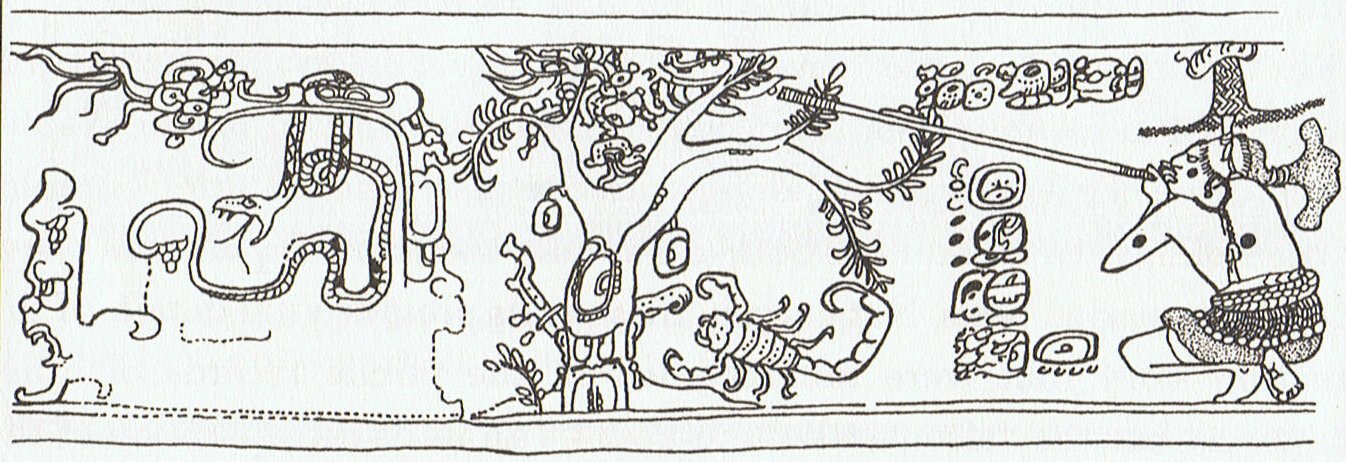
Orion is rising
slightly after the Pleiades (Matariki) and for the Maya the
Turtle was 'hanging' below
the ecliptic. The Mayan Turtle with 3 stones was the Belt of Orion,
which could explain Tolu - if we consider
Tula-lupe, Mataliki and Tolu as a group (Tula
and Tolu are forming a wordplay pair). Classical
writers said Orion the mighty hunter was 'blind', and the 3
stones could allude to a missing 'fire'.
Gemini
comes after Orion and the twin months Palolo-mua and
Palolo-muli come after Tolu. The logic of time
order will force us to say that tula in Tula-lupe
means that there are no prominent constellations (no 'fire') before Mataliki
(the little 'eyes'). A new 'year' is therefore beginning with the Pleiades.
Orion was seen as
a bird snare by the Maori, a place where the 'bird' got stuck and couldn't move
away:
"Pewa-o-Tautoru,
Bird-snare-of-Tautoru; the constellation Orion in New
Zealand. The Belt and Sword form the perch, te mutu
or te teke, while Rigel is the blossom cluster, Puanga,
used to entice the unsuspecting bird. To visualize the bird-snare we must remember
that Orion, as we see it in the northern hemisphere, is
upside down to the view obtained from New Zealand where
Orion stands in the northern sky." (Makemson)

(Picture from Text Centre)
Makemsons remark also
means that for the Maori the belt stars were not down in the 'water'
(below the ecliptic) but up on 'land'.
Ua-roa
indicates 'water', Tula-lupu refers to 'air', and 'land'
is definitely reached with Mataliki. There are 3 double-months before
Ua-roa and these could indicate the 'front side'. From
Mataliki we can count 4 (or 5) regular months (for the
'back side').
8 (or 5) months are
needed before 'land' arrives with Mataliki. Tula-lupe
could correspond to Te Pei and Te Pou (Sirius)
could correspond to Tolu - also the kuhane station
Te Pou lies in July (according to Barthel 2).
Maybe Sirius (Reitaga
on Easter Island)
was imagined as the 'pigeon' caught in the snare. Its fame is based not only
on brightness but also on its power to remain standing still
in spite of the precession (at least in ancient Egyptian times).
Taga means 'sack'. The form of the bird snare 'stick' is not
very far from the shape of a toki. |
|
4.
542 days in the Mayan system is 1.9.2, strangely like number 192
(which occurs in the rongorongo
texts). After 542 (possibly to be read as 5 * 42 = 210 = 192 + 18)
days Hun-Nal-Ye
'entered or became the sky'. Great powers do not merely 'enter'
through a doorway, they immediately will dominate (take possession of)
the new room.
A man of power entered
the room and everybody stopped talking to watch him. Not out of
curiosity, but by deference. Not by cause of his rank or reputation,
but by cause of his personality. The room grew
lighter when he entered, attention was called for. He had mana. Therefore Hun-Nal-Ye
became the sky when he entered the sky and the date was February 5,
3112 B.C.
Different levels of the cosmic order are inhabited at
different times by the Sun (alias the Rain God, cfr at henua
and at maitaki). It is to be noted
that he has different
kinds of
'sticks' in different seasons:
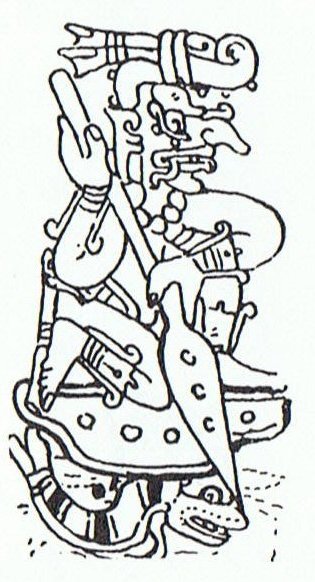 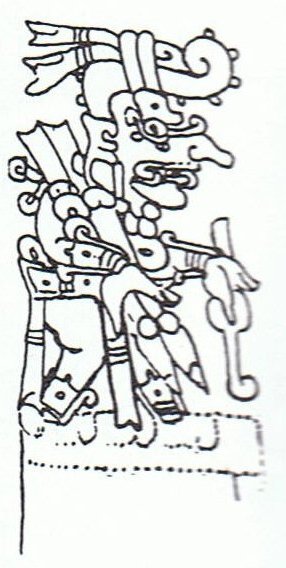 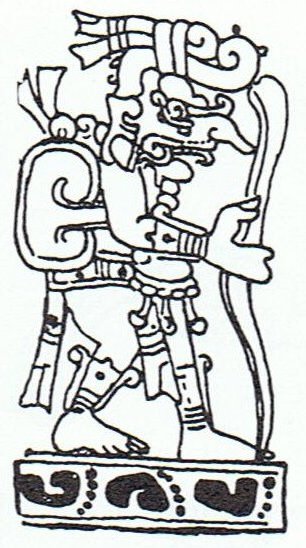 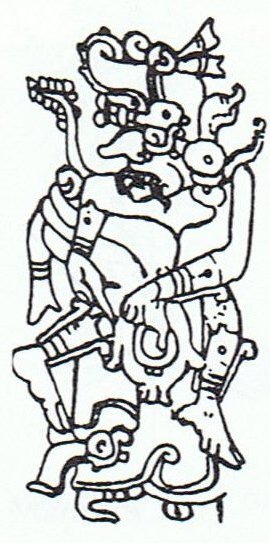
'Water', 'air',
respectively 'land', is followed by a climb in
the cosmic tree, and its (the head at the bottom) reversed orientation
probably means the year is
ending. Next sequence shows how the Rain God has his 'sticks' held high
instead of in a low position:
 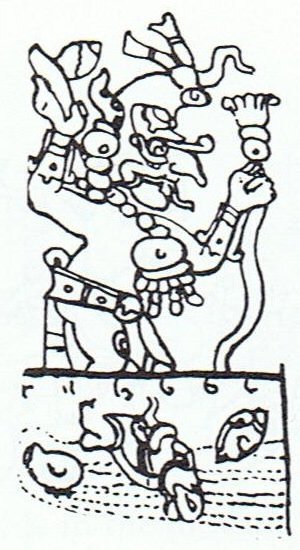 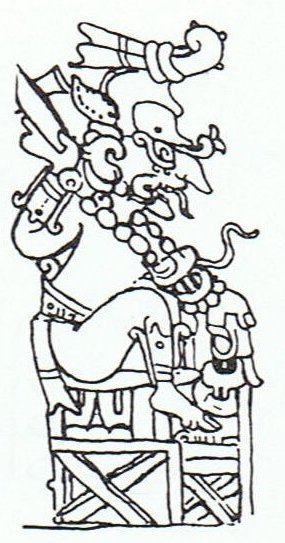 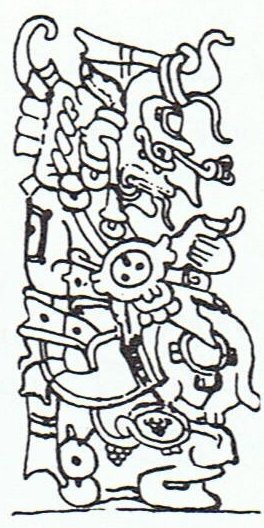
The symmetry includes
'alighting' in the cosmic tree in
the 4th position. 4 + 4 = 8 are the number of stations. But there is
no reversed orientation in this station, which presumably indicates
that the journey continues. If so, then the beginning should be with
the station which I have in position 5 above, the exceptional station
where the Rain God is sitting hidden inside the earth.
It is probably no coincidence that he carries no 'stick' in this
station.
The journey of the Rain God (Sun) has 8 stations and
seems to begin where he cannot be seen. In the beginning there is no
light and we are in the station of the
blind Orion (Te Pei), where the Rain God is 'in the sack',
i.e. Sky and Earth
are lying in close embrace:
... the Palenque scribes repeated Creation again and described it as
'it was made visible, the image at Lying-down-Sky, the
First-Three-Stone-Place' ...
If any of the Rain God stations is connected with
toki, it should be the one following the dark station, in which
we can see him as a true rain god, wading in water with a water lily in his hand.
And he is holding high a kind of hewing implement.
Possibly we can see the Mayan sign for flint
knife (etz'nab), because of the wavy line across:
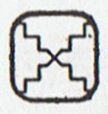
In this (double) form it is the sign for day 18 in the Mayan
calendar.
The single wavy line in the
'adze' of the Rain God can allude to lightning (flint stones are
used to generate sparks) and there may be a connection with the
kava glyph type:

Presumably the Rain God can be said to 'enter the sky'
(and also to 'become the sky') when he
emerges from the embrace of Mother Earth.
Is the
kava sign on its way to stretch itself in order to become a
henua sign, and then like an umbrella extend itself to become a
'roof'? It cannot become a parasol because night comes
before daylight.
|
|